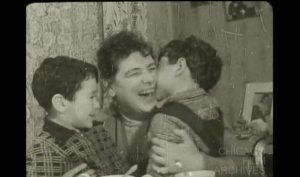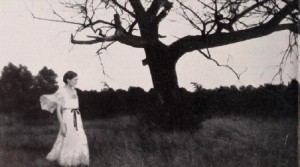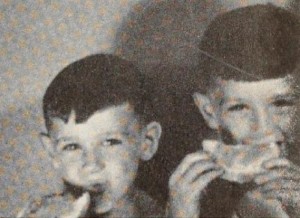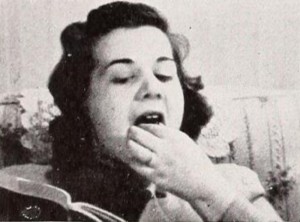
"A group of children learn in school that tomorrow will be “Woman’s Day”, the equivalent of our “Mother’s Day”, then the humorous story unfolds in a delightful and charming manner of how two small boys decide to celebrate this occasion. An amateur film made by a Russian filmmaker and distributed by the Society of Amateur Cinematographers (SAC). All title cards are in Russian." Chicago Film Archives
A six-minute film that documents the annual procession of the Gion Festival in Kyoto on July 17, 1941. The film opens with several consecutive intertitles explaining a brief history of the festival. As he cut from one intertitle to the next, Hattori used the splicer to create the effect of a diagonal wipe, which made it appear as if the viewers were turning a page of a book.

"In his one reel film, Girl with a Dress, Clyde Hammond, ACL, has made an appealing and remarkably successful attempt to portray a drama of the spirit rather than of action. Through long weeks of bitter economy a girl accumulates enough money for a new dress. It arrives from the mail order house just in time for a summer's picnic with her friends and, happy in prospect, she wears it proudly. Then, because in it she is more charming than they, her friends will not like it, make mocking fun of her and she leaves them in tears. Stumbling home, she is caught in a shower and the dress is ruined. A simple enough tale, but in its very simplicity and sincerity lie the strength of downright tragedy. It was planned and directed with imagination and played, in its leading role, with definite and sensitive skill." Movie Makers, Dec. 1932, 562.

"Going back to The Lord's Prayer for the title of his picture, A. T. Bartlett has produced a handsome, heart-warming and technically able documentary on the theme "Our Daily Bread." In it one follows the staff of life from the vast and golden wheat fields of Australia, through the harvesting and milling of the grain, into the baker's hands and onto my lady's table. Give Us This Day is intelligently planned, smoothly developed and suavely executed. A simple but satisfying narrative continually relates the subject — as it should be — directly to human needs, and a pleasant musical score rounds out the presentation. Especially to be commended is the minimum of footage used by Mr. Bartlett in reporting on this age-old activity of mankind." Movie Makers, Dec. 1952, 339.
"In the Certificate Awards group, Ralph E. Gray, a consistent winner in national film competitions and recently honored with the title of Leading Amateur Movie Maker of the nation by the Movie Makers Club of Oklahoma and associated cine clubs, has turned in another of his superb filming jobs in 'Glamorous Guatemala.' A highlight is the excellent titling job, a department of movie making in which Gray excels. Gray opens his picture with scenes of modern day Guatemala, then gradually leads us into more remote areas of the country where he shows the native Guatemalan at work and at play, harvesting coffee, weaving, and trucking his wares to market, or indulging the religious ceremonials and market day festivities, which comprise his chief diversions. Gray filmed his picture using a Cine Special and Kodachrome film." American Cinematographer, April 1950, 134-135.

"In Glamour vs. Calories, C. J. Carbonaro has again turned to light comedy with a story of a wife who suspects her husband's infidelity because of her mounting avoirdupois. Excellent directorial touches are found in the scenes that would tend to corroborate her misgivings, especially in those of the gossip mongers. Many fine closeups that "plant" the suspicions contribute to the gaiety of the film, such as when the wife stoops to pick up some papers her husband has unsuspectingly dropped, only to have the seam of her dress rip from the strain. The film has interesting camera viewpoints and intelligent use of dissolves and double exposure to point up the plot. A word must be said for Mrs. Carbonaro's fine work as assistant cameraman, made necessary by the fact that her husband played one of the major roles in addition to being producer of the film, and for the high key titles with their amusing sketches. And we might add a salute to the good sportsmanship of the girl who played Mrs. Tubby, who finds a happy ending." Movie Makers, Dec. 1944, 494.
"The newsreel begins with the departure of the ocean liner -'Britannic'- on its maiden voyage from Liverpool to New York; 28th June 1930. Further scenes include an item on the Liverpool and Manchester Railway Centenary Exhibition held in 1930 at Wavertree Park - visitors are seen wandering around the various exhibits, which comprise of both old and new locomotives." (NWFA Online Database)(br>
"The grand rail exhibition at Liverpool's Wavertree Park on 20th September 1930 marked the centenary of the Liverpool and Manchester railway. In this fascinating glimpse of a significant event in railway history, enthusiasts admire the gleaming locomotives, which include North Star and a replica of the Rocket as well as more contemporary models from the LMS, LNER, GWR and Southern rail companies." (BFI Player)
"Local newsreel events include carnival scenes at Winsford, Cheshire. Dancing troupes, decorated floats and various fancy dress characters march along the country lanes. Also features the Southport Flower Show held on August 24th,1934. Includes indoor exhibits, rock gardens and an outdoor swimming pool. Concludes with the crowning ceremony of Morecambe carnival queen. Crowds of people, sitting in rows of deckchairs, watch the event taking place." (NWFA Online Archive)
"Local newsreel - includes items on the 'New World Wonder Tunnel' in Merseyside, March 31st 1934; Manchester City football team is welcomed home after winning the FA cup at Wembley - includes scenes at North Edgeley Station and Piccadilly Square - A royal visit to Manchester and Liverpool, July 17th / 18th, 1934. King George V is greeted by large crowds as he opens the new Central Reference Library in Manchester and the new East Lancashire Road in Liverpool. The newsreel concludes with shots of Stockport’s floral tributes." (NWFA Online Archive)
Total Pages: 203